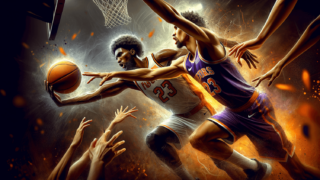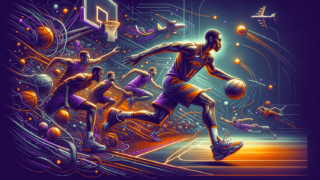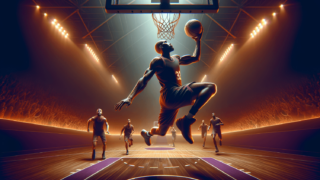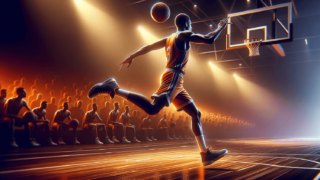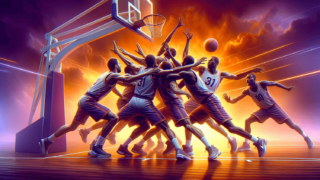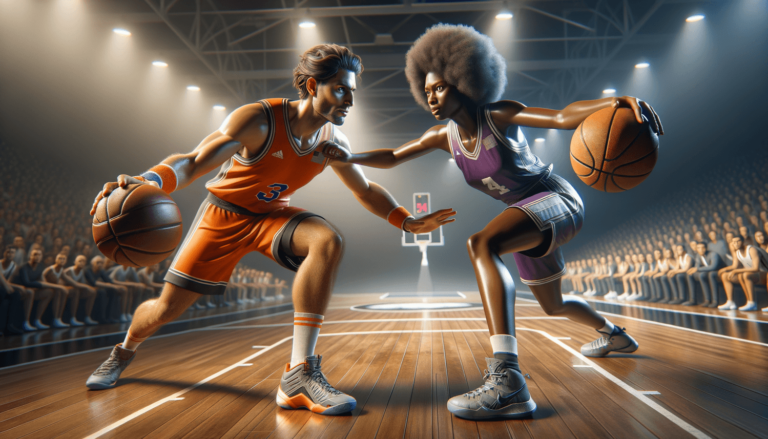
How to Become a Better Basketball On-Ball Screen Defender?
Written by: Basketball Universe
Last updated:

It’s no secret that mastering the art of on-ball screen defense is crucial for any basketball player looking to make an impact on the court. If you’ve ever wondered how elite defenders seem to effortlessly navigate the maze of high-powered screens, you’re in the right place! In this blog post, we’ll dive deep into the nuances of on-ball screen defense, equipping you with the knowledge, techniques, and strategies that coaches and scouts love to see. So, lace up your sneakers, adjust your wristbands, and get ready to unlock your true defensive potential on the hardwood!
How to Become a Better Basketball On-Ball Screen Defender?
To become a better basketball on-ball screen defender, focus on improving your communication, body positioning, footwork, and anticipation. Actively communicate with your teammates on the court, concentrate on maintaining a low and balanced stance, develop quick and agile footwork to navigate screens, and study the tendencies of opposing players to anticipate their movements. These essential skills, combined with consistent practice and a strong defensive mindset, will help you excel as an on-ball screen defender.
Master the Fundamentals of Communication and Awareness
Communication and court awareness play pivotal roles in on-ball screen defense. Make sure to constantly converse with your teammates to exchange critical information about matchups, screens, and possible switches. The more in sync you are with your teammates, the easier it will be to navigate those tricky on-ball screens.
Develop Adept Verbal and Nonverbal Communication Skills
Learning to communicate effectively on the court goes beyond simply talking. Incorporate hand gestures, nods, or other forms of nonverbal communication to relay vital information without tipping off your opponents. Ensure that the whole team is on the same page to create a basketball defense that rivals even the best offenses.
Know Your Team’s Defensive Terminology
Every team has its preferred way of referring to different defensive strategies and calls. Familiarize yourself with the terminology used by your coaches and teammates to facilitate rapid communication when defending against an on-ball screen.
The Art of Body Positioning and Footwork
Being in the right place at the right time is critical to on-ball screen defense. Proper body positioning and footwork allow you to react swiftly and efficiently without leaving holes in the defense.
Adopt a Low, Balanced Stance
When defending against an on-ball screen, maintain a low stance with your knees bent and your chest up. This position will enable quick reactions to the screen, whether you choose to fight through it, switch with your teammate, or hedge the offensive player.
Swift, Agile Footwork
The key to effective on-ball screen defense is moving your feet quickly and efficiently. Spend time in practice honing your footwork to navigate screens with grace and ease. Drills like lateral slides and crossover steps can help enhance your foot speed and overall defensive performance.
Anticipation Fueled by Basketball IQ
A high basketball IQ fosters the ability to read and anticipate your opponents’ actions. By understanding the tendencies of the opposing team and utilizing your knowledge of basketball strategy, you can be one step ahead of the offense.
Scout Your Opponents
Become a student of the game and study your opponents’ film, analyzing their preferred offensive sets and plays. Look for patterns in how they use on-ball screens – you might find valuable insights to help you disrupt their offensive rhythm.
Sharpen Your Basketball IQ
Expand your basketball knowledge by watching games, discussing strategies with coaches and teammates, and exploring advanced statistics. The greater your understanding of the game, the better equipped you’ll be to anticipate on-ball screens and make split-second decisions on the court.
Learn From Your Mistakes
Even the best defenders are bound to get caught on on-ball screens occasionally. Review film of your performances and identify areas needing improvement. Recognize your mistakes and focus on refining your game to evolve as an on-ball screen defender.
Embrace Different Defensive Techniques
On-ball screen defense is not one-size-fits-all. Familiarize yourself with various defensive techniques to adapt to different game situations, opponents, and coaching styles.
Fighting Through the Screen
One method to defend against on-ball screens is to “fight through” – navigating around the screener while maintaining contact with the offensive player. To do this, plant your foot closest to the screener, get low, and slide around the screen while keeping your hand on the ball handler’s hip to deter their drive.
Switching
Switching is a common defensive technique wherein you and your teammate trade assignments as the screen occurs. Proper communication is key – discuss the switch beforehand or communicate loudly during the screen to avoid confusion.
Hedging
Hedging is when the defender guarding the screener momentarily helps contain the ball handler. This technique provides temporary pressure on the ball handler, allowing the primary defender to recover their position. As the primary defender regains their position, the hedging defender quickly returns to their original assignment.
Boost Your Physical Conditioning
Being in peak physical condition directly contributes to your ability to successfully defend on-ball screens. Developing strength, speed, and quickness will require dedicated effort off the court, but the benefits will be undeniable on the hardwood.
Strength Training
Core and lower body strength are essential for effective on-ball screen defense. Incorporate exercises like squats, lunges, and deadlifts into your workout routine to build the necessary foundation for powerful defense.
Speed and Quickness Training
Speed and quickness are vital for agile footwork and rapid defensive adjustments. Regularly engage in drills focusing on agility, such as ladder drills and sprint interval training, to refine your on-ball screen defense skills.
Improve Your Cardiovascular Fitness
Endurance is crucial for maintaining a high level of defense throughout the game. Invest time in cardiovascular training methods like running or cycling, and don’t forget to emphasize high-intensity interval training (HIIT) to better simulate game conditions.
Maintain a Positive, Resilient Mindset
Defensive prowess is not solely rooted in physical ability. Developing a strong, resilient mindset can be equally as important to achieve on-ball screen defensive success.
Embrace Challenges
Defending against skilled offensive players can be a demanding task, but embracing these challenges with confidence can help to elevate your game. Keep believing in your abilities, and remember that no offensive player is unstoppable.
Play With Passion and Determination
Excel as an on-ball screen defender by bringing energy, enthusiasm, and diligence to your game. A tenacious attitude combined with hard work can help solidify your reputation as a relentless on-ball screen defender.
By focusing on these essential aspects of on-ball screen defense, you’ll become an indispensable asset to your basketball team. As you continue to learn and grow, you’ll find that the keys to unlocking your full defensive potential lie in a combination of honed skills, diverse techniques, and a dedicated mindset.
Additional Drills to Enhance On-Ball Screen Defense
Integrating specific drills into your practice routine can help speed up your on-ball screen defense improvement. Here are some training exercises that focus on sharpening the key aspects of on-ball screen defense:
Closeout Drills
Closeout drills teach players how to quickly approach and defend a ball handler after recovering from a screen. To perform a closeout drill, start a few feet away from your imaginary opponent, sprint towards them, and shuffle your feet when closing in, maintaining a low stance and active hands. Repeat this drill to develop the required quickness and control for on-ball screen defense.
Partner Screen Drills
Partner screen drills mimic real-game scenarios by involving another player as the screener. In these drills, a coach or teammate will call out different screen situations, while the defender navigates on-ball screens set by their partner. This exercise will help you develop the necessary reaction skills, communication, and adaptability needed for on-ball screen defense.
Defensive Slide Drills
Defensive slide drills focus on proper footwork, body positioning, and maintaining balance during lateral movement. Start at one end of the court, and as you slide laterally, keep your body low, maintain a wide base, and avoid crossing your feet. Reach the other end of the court, and then slide back towards the starting point. Repeat this process to cultivate the critical footwork skills essential for on-ball screen defense.
Watch and Learn from the Best
Studying top defenders can provide valuable lessons on successful on-ball screen defense. Observe how elite players communicate, position themselves, and anticipate offensive moves. By analyzing their techniques, you can learn strategies and tactics that you can incorporate into your own defensive repertoire.
Learn From All-Time Greats
Players like Gary Payton, Michael Jordan, and Scottie Pippen are renowned for their on-ball screen defense skills. Watch some of their best defensive games and notice how they handle different screen situations, use footwork, and communicate with teammates. Learning from these legends can be an excellent source of inspiration and knowledge for your growth as a defender.
Analyze Current NBA Stars
Some of the best on-ball screen defenders in today’s NBA include Kawhi Leonard, Jrue Holiday, and Marcus Smart. Watching these players work their magic on the court can provide valuable insights into modern on-ball screen defensive strategies. Analyze their techniques, tendencies and apply what you learn to your own game.
Armed with the knowledge and tools discussed in this article, you’re well on your way to becoming a formidable on-ball screen defender. Remember that practice makes perfect – the more time you dedicate to honing your skills, the better you’ll become. Equip yourself with the right mindset and work ethic, and you’ll have a strong foundation for success on the basketball court.
FAQ Section: On-Ball Screen Defense
In this section, we’ve compiled some frequently asked questions related to on-ball screen defense. We hope these answers will help you better understand and improve your on-ball screen defense skills.
1. What is an on-ball screen in basketball?
An on-ball screen, also known as a pick, occurs when an offensive player sets a stationary screen for their teammate, who has the ball. This screen is usually aimed at creating space and opportunities for the ball handler to either shoot, drive, or pass by temporarily stopping or impeding their defender’s movement.
2. How can I quickly navigate through screens?
To quickly navigate through screens, maintain a low, balanced stance, use agile footwork, and anticipate the screen’s direction. Keeping your hand on the ball handler’s hip and having good communication with your teammates will also help you react promptly to screens.
3. What is the safest way to handle a screen?
The safest way to handle a screen depends on your defensive strategy and the specific game situation. You may choose to fight through the screen, switch assignments with your teammate, or temporarily hedge the ball handler. Proper communication and anticipation will help you determine the best course of action.
4. What is the difference between hedging and switching?
Hedging is a temporary on-ball screen defense technique where the defender guarding the screener steps out to momentarily contain the ball handler. This action allows the primary defender to recover their position. Switching, on the other hand, is when two defenders involved in the on-ball screen scenario trade assignments permanently for the duration of that play.
5. How can I improve my footwork for on-ball screen defense?
Improving your footwork for on-ball screen defense involves practicing drills that focus on lateral movement, quickness, and balance. Defensive slide drills, ladder drills, and crossover steps can help enhance your foot speed and overall defensive performance.
6. How can I maintain my balance while defending an on-ball screen?
Maintain balance while defending an on-ball screen by adopting a low stance with your knees bent and your chest up. Keep your feet shoulder-width apart, and avoid crossing your feet as you move laterally. Also, focus on your core strength to improve overall balance and stability.
7. How important is communication in on-ball screen defense?
Communication is crucial in on-ball screen defense as it helps ensure proper coordination and collaboration between teammates. Clear and consistent communication allows defenders to call out screens, share vital information, and execute defensive adjustments or switches as needed.
8. What should I focus on when studying my opponents’ film to defend on-ball screens?
When studying your opponents’ film, focus on identifying their preferred offensive sets and plays, patterns in how they use on-ball screens, and the tendencies of individual players who often utilize screens. Gaining these insights will help you anticipate and disrupt their offensive rhythm.
9. How can I be more aggressive in my on-ball screen defense without fouling?
Be more aggressive in your on-ball screen defense by maintaining a low stance, using active hands to discourage passes or drives, and exhibiting quick footwork to stay in front of the ball handler. Remember to avoid overly reaching for the ball or making excessive body contact to prevent fouls.
10. How important is physical conditioning for on-ball screen defense?
Physical conditioning is vital for on-ball screen defense as it directly impacts your ability to react swiftly and efficiently during the game. Focusing on strength training, speed and quickness training, and cardiovascular fitness will contribute to enhancing your on-ball screen defense performance.
Featured Posts
- No pillar pages found.
